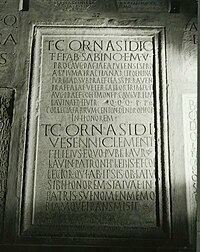Legion II Augusta
The Legio II Augusta (Second Legion «of Augustus») was a Roman legion, probably created by the consul Gaius Vibio Pansa and Augustus in 43 BC. C., to fight against Marco Antonio, participating in the battles of Philippi and Perugia.
His emblems were the Capricorn and later he was awarded the Pegasus under Vespasian.
The legion in Hispania
At the beginning of the Augustan empire, in 25 B.C. C., the legion was transferred to the Iberian Peninsula, where it participated in the Cantabrian wars against the Cantabrians and the Astures in a series of long campaigns that lasted until 19 BC. C..
It was assigned to the army of the Tarraconensis province, and its base was perhaps in Augusto's camp in Segisama Iulia (Sasamón, Burgos), until it was transferred to the Danube at an indeterminate moment between the end of the Cantabrian wars and 13 a.m. C.-12 B.C. c.
Veterans of this legion, along with others of the Legio I Germanica (formerly Augusta), as indicated by some local Hispano-Roman coins, were settled in the Colonia Iulia Gemella Acci (Guadix, Granada) sometime before the unit left Hispania.
The Legion in Germany
The disaster at Varo in the Teoteburgo forest, with the annihilation of the XVII, XVIII and XIX legions by the Germans in the year 9, meant that the II Augusta was assigned to Germania Superior, possibly to the great camp of Mogontiacum (Mainz, Germany), during the rule of Germanicus. Later, from 17 to 43, it was stationed in the Argentoratum camp (Strasbourg, France), in the Germania Superior military district.
The Invasion of Britain
In that year he took part in the invasion of Britain under the command of Emperor Claudius, serving as his legacy the future Emperor Vespasian, reaping important successes in the conquest of the island until being considered an elite unit, calling it &# 34;the best Vespasian".
However, for reasons never clarified, their field prefect did not obey the order of Gaius Suetonius Paulinus to join the troops that were to put down Queen Boudica's rebellion, so they did not participate in the Battle of Watling Street and they were disgraced.
With the pacification of the local tribes, the legion was divided and dispersed into several detachments based in southwestern Britain. Finally, in 48, the fort of Isca Dumnoniorum (Exeter) was completed, concentrating the legion again.
The legion under the Flavians and the Antonines
In 66, during Queen Boudicca's rebellion, this legion performed poorly, and was then stationed for a short time at Glevum (Gloucester). In 69, after the civil war for the succession of Nero, the II Augusta initially sided with the Emperor Vitellius, marching towards Rome with other units and defeating Otto. Disappointment with Vitellius soon made them openly support their former commander Vespasian, eventually Emperor of Rome.
In 74 it was removed to Isca Silorum (probably modern Caerleon) in south Wales, building a stone fort that would be occupied until the 3rd century.
Commanded by the governor of Britain, Gnaeus Julius Agrícola, between 78 and 84, the legion would participate in the subjugation of the tribes of the Scottish highlands, with important victories. Even so, the domination was never complete and the occupation of these territories impossible.
In the year 122 he participated in the construction of Hadrian's wall.
The Legion under the Severi
After the rebellion of Clodio Albino, governor of Britain, who claimed the imperial throne, the II legion along with others was shipped to the continent but were defeated in the year 197 by the emperor Septimius Severus.
When the legions wanted to return to Britain, they found a province invaded by the Pictish tribes of present-day Scotland. Under Septimius the II Augusta was moved north, where it shared an important fort with the Legio VI Victrix at Carpow.
Septimius Severus' campaign would not last long, resigning himself to abandoning the territories beyond Hadrian's wall and fortifying it. Later the legion would be transferred again to Isca Silorum, where it would remain definitively until the collapse of the Roman occupation of the province.
Under Emperor Caracalla the II Augusta received the name Antoniniana in reward for the services rendered to him and his father in Britain.
The decline of the empire and the disappearance of the legion
At the beginning of the IV century, in the midst of the collapse of the Roman Empire, the Legio II Augusta was part of the defense of the south coast at Rutupiae (Richborough) against the barbarian invaders. In the year 407, he definitively abandoned Britain, called to the continent by the usurper Constantine III. It was possibly destroyed in the combats that preceded the fall of Constantine III against the troops of Honorius.
Narrative
- Eagle Series (Historical novel series by Simon Scarrow). In the first novels of the series the protagonists belong to the Legio II Augusta.
- Marco Didio Falco series (series of detective novels in the days of the Flavia Lindsey Davis dynasty). Marco Didio Falco and his friend Petronio Longo belonged to Legio II Augusta.



